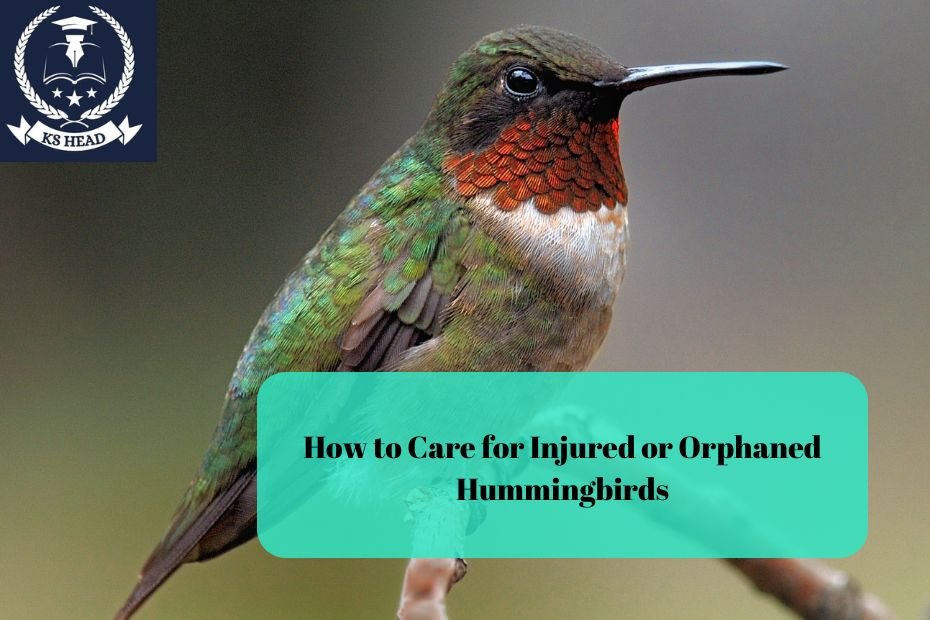Hummingbirds are tiny, vibrant creatures known for their rapid flight and delicate beauty. Because of their small size and energetic nature, they can be vulnerable to accidents, injuries, or even being orphaned. If you come across an injured or orphaned hummingbird, it’s natural to want to help. However, caring for these fragile birds requires a specific approach to ensure their best chance of survival and eventual release back into the wild.
In this article, we’ll cover everything you need to know about caring for injured or orphaned hummingbirds, from understanding their needs to providing the right care until you can hand them over to a professional wildlife rehabilitator.
Identifying Injured or Orphaned Hummingbirds
Signs of an Injured Hummingbird
Hummingbirds can become injured due to collisions with windows, entanglement in spider webs, being attacked by predators, or being struck by vehicles. Common signs of injury include:
- Inability to Fly: If a hummingbird is flapping its wings but cannot get off the ground, it may have a wing injury.
- Lethargy or Weakness: Hummingbirds are usually energetic and rarely sit still. A hummingbird that is sitting in one place for an extended period, looking listless, or has drooping wings might be injured.
- Visible Wounds or Bleeding: Look for signs of physical trauma, such as cuts or bleeding, especially on the wings or legs.
- Difficulty Breathing: Hummingbirds breathe quickly, but labored or heavy breathing is a sign that something is wrong.
Identifying an Orphaned Hummingbird
Sometimes, you may come across a baby hummingbird that seems abandoned. However, not all baby birds need rescuing. Here’s how to determine if a hummingbird is orphaned:
- Nest Displacement: If a baby hummingbird is found on the ground with no nest nearby, it may have fallen out or the nest may have been destroyed.
- No Sign of Parents: Adult hummingbirds feed their babies frequently. If the baby bird is left alone for more than 30-60 minutes without any sign of an adult returning, it may be orphaned.
- Fledgling or Nestling: A nestling is too young to leave the nest, while a fledgling may hop around outside the nest as part of its natural development. Fledglings generally do not need rescuing unless they are in immediate danger.
Immediate Steps to Take
If you’ve determined that the hummingbird is injured or orphaned, follow these immediate steps:
1. Minimize Handling
Hummingbirds are extremely delicate, and too much handling can cause additional stress or injury. If possible, wear gloves and handle the bird as gently as possible.
2. Place the Bird in a Safe Environment
Use a small box lined with soft tissue or a cloth to create a temporary safe space for the bird. Make sure the box has ventilation holes and is large enough for the bird to move slightly. Keep the bird in a quiet, dark, and warm environment to reduce stress.
3. Keep the Bird Warm
Hummingbirds have very high metabolisms and can quickly go into shock if they become too cold. You can use a heating pad set to low or a warm water bottle wrapped in a towel placed under half of the box. Be careful not to overheat the bird.
4. Avoid Feeding Right Away
While your first instinct may be to feed the bird, it’s essential to avoid doing so immediately. Injured or weak hummingbirds may not be able to digest food properly, and feeding them too soon can cause harm. Only feed when the bird is stable, and preferably under the guidance of a wildlife expert.
Feeding Injured or Orphaned Hummingbirds
Hummingbirds require specialized diets, and feeding them improperly can be fatal. Here’s how to approach feeding:
1. Use Sugar Water
If the bird is a mature hummingbird, you can prepare a temporary sugar-water mixture until you can hand it over to a rehabilitator. Mix one part white granulated sugar with four parts water. Boil the water and let it cool before offering it to the bird. Never use honey, artificial sweeteners, or juices.
2. Avoid Overfeeding
Hummingbirds need to eat frequently due to their high metabolism, but overfeeding can overwhelm their digestive systems. Offer only a small amount of the sugar water using a dropper or syringe.
3. Special Formula for Babies
Orphaned baby hummingbirds require a specialized formula that mimics their natural diet. You should not attempt to feed them until you can consult with a wildlife rehabilitator, as improper feeding can be fatal.
4. Offer Feeding Every 20-30 Minutes
If you’re caring for an adult hummingbird while waiting for professional help, they may need to eat every 20-30 minutes during daylight hours. Place a small dish of sugar water near the bird or offer a few drops of the solution through a syringe.
Contact a Wildlife Rehabilitator
The most important step you can take is to contact a licensed wildlife rehabilitator as soon as possible. Caring for hummingbirds is a highly specialized task, and professionals have the tools, knowledge, and experience needed to provide the best care.
Finding a Wildlife Rehabilitator
You can search for a licensed rehabilitator by contacting your local animal control, wildlife agency, or vet. Many wildlife rehabilitation centers have experience with hummingbirds and can offer guidance over the phone or direct you to someone who can help.
Transporting the Bird
If instructed to transport the bird, keep it in the same safe box you initially placed it in. Ensure the bird is secure, and minimize noise or movement during transportation. If possible, keep the bird warm during the trip.
Long-Term Care Considerations
If you’re in a situation where you need to care for the hummingbird for an extended period before a rehabilitator is available, keep these considerations in mind:
1. Provide a Clean and Quiet Space
Hummingbirds are sensitive to noise and stress. Keep the bird in a calm, clean, and quiet environment. Avoid placing the bird near other animals or busy areas of the home.
2. Hydration is Key
Dehydration is a significant risk for hummingbirds, especially injured ones. Sugar water will provide hydration, but never offer plain water, as they can drown in it or choke.
3. Monitor Behavior
Keep an eye on the bird’s activity levels, alertness, and eating habits. If the bird is becoming more active, it is a good sign of recovery, but continued lethargy or difficulty breathing may indicate worsening health.
4. Exercise for Flight
If the bird’s wings are not injured, it may need to practice flight before being released. This requires careful attention and a safe space. If the bird shows signs of being ready for release, consult a rehabilitator for guidance.
Releasing the Hummingbird
If the hummingbird is fully recovered and a rehabilitator has given approval, you may be able to release the bird back into the wild. The release process should be done carefully:
- Choose the Right Time and Location: Release the bird during daylight hours when it can safely find food and shelter. Pick a location where hummingbirds are known to thrive, such as near gardens or parks with plenty of flowers.
- Observe Before Fully Releasing: Open the container and allow the bird to leave on its own. Observe from a distance to ensure the bird is able to fly and orient itself before leaving the area.
Preventing Injuries to Hummingbirds
Prevention is the best way to protect hummingbirds. Here are a few tips to reduce the chances of injury:
1. Use Window Decals or Screens
Hummingbirds often collide with windows because they don’t perceive the glass as a barrier. Use window decals, screens, or other bird-safe devices to prevent collisions.
2. Place Feeders Properly
If you have hummingbird feeders, place them away from potential hazards like windows, power lines, or areas with high predator activity.
3. Keep Cats Indoors
Cats are a significant threat to birds, including hummingbirds. Keeping your cats indoors will reduce the risk of attacks.
4. Avoid Pesticides
Pesticides can harm hummingbirds by contaminating the flowers and insects they rely on for food. Use eco-friendly, bird-safe gardening methods.
Conclusion
Caring for injured or orphaned hummingbirds requires compassion, patience, and attention to detail. These tiny birds are fragile, and even a well-meaning mistake can be harmful. The best course of action is to contact a wildlife rehabilitator as soon as possible, but until then, following these steps can help keep the bird safe, warm, and fed. With proper care, these delightful creatures can recover and return to the wild, where they belong.
FAQs
1. What should I do if I find an injured hummingbird?
Place the bird in a safe, warm environment, and contact a wildlife rehabilitator immediately. Handle the bird as little as possible.
2. Can I feed an injured hummingbird nectar from my feeder?
It’s better to feed a sugar-water mixture made from one part white sugar to four parts water. Avoid feeding honey, artificial sweeteners, or commercial nectars.
3. How do I know if a baby hummingbird is orphaned?
If the nest is destroyed or if the parent bird does not return for more than an hour, the baby hummingbird may be orphaned.

